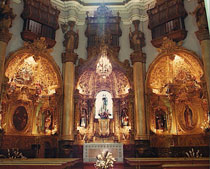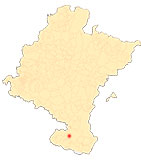The Church of the Company of Mary (Tudela)
By Ricardo Fernández Gracia
Triumph of the Baroque style in the interior: plasterwork, tribunes and altarpieces.
Apart from the genius of the building as an architectural project that makes it the most genuinely baroque building in Navarre's architecture, within a more international trend that was making its way in the central decades of the Age of Enlightenment.
The art of the period and culture of the centuries of the Baroque is based on sensory impact, grandiloquence, ornamentation, excess, extravagance and is intended to move, impress, enervate and provoke the individual sensorially, marking behaviour through the senses, always more vulnerable than the intellect, with the aim of awakening and moving the affections by all means and in all ways.
The set of three altarpieces in the church of teaching is a complement to the beautiful and interesting Baroque architecture. They were made around 1745, and in them the triumph of the delicacy of Rococo art is announced through the careful decoration of small, curly foliage. Another interesting part of the altarpiece as a whole is the tabernacle, which incorporates small slanted stipes, very similar to those of the side altarpieces of San Jorge in the same city of Tudela. In the central one, the patron saint is accompanied by her parents in two sculptures of discreet quality and from the period of the altarpiece.
The images of the collaterals have been replaced on several occasions and in the last restoration of the temple some of them were replaced, as well as the title of both, which were dedicated to San Rafael, special protector of the community since its foundation, and to the Virgin of Guadalupe, by the wishes and sponsorship of Sister María Ignacia Azlor. The canvas of San Rafael is a painting by Vicente Berdusán from the time of the foundation of the high school around 1687, the painting of the Guadalupana is a New Spain canvas brought by the future foundress of the high school of Mexico during her stay in the capital of La Ribera.
-
PUIG Y ARBELOA, M. C., review histórica de la fundación del convento de religiosas de la Compañía de María y teaching de Tudela, Madrid, Imprenta a position de D. R. P. Infante, 1876.
-
FOZ Y FOZ, M. P., La revolución pedagógica en Nueva España 1754-1820 (María Ignacia de Azlor y Echeverz y los colegios de la teaching), Madrid, high school Gonzalo Fernández de Oviedo, 1981.
-
ECHEVERRÍA GOÑI, P., and FERNÁNDEZ GRACIA, R., "La arquitectura religiosa de los siglos XVI al XVIII en Navarra", Ibaiak eta Haranak. guide del Patrimonio artístico y paisajístico. Navarra, vol. VIII, San Sebastián, Etor, 1991.
-
AZANZA LÓPEZ, J. J., Arquitectura Religiosa Barroca en Navarra, Pamplona, Government of Navarre, 1996.
-
FERNÁNDEZ GRACIA, R., The Baroque altarpiece in Navarre. Pamplona, Government of Navarre, 2003.
-
CARRASCO NAVARRO, C., Los palacios barrocos de Tudela. Arquitectura y Nobleza, Tudela, Castel Ruiz- M. I. Ayuntamiento de Tudela, 2014.












